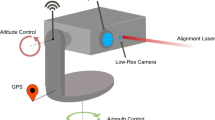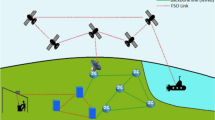Abstract
Existence of line of sight (LOS) and alignment between the communicating antennas is one of the key requirements for free-space-optical (FSO) communication. To ensure uninterrupted data flow, auto-aligning transmitter and receiver modules are necessary. We propose a new FSO node design that uses spherical surfaces covered with transmitter and receiver modules for maintaining optical links even when nodes are in relative motion. The spherical FSO node provides angular diversity in 3-dimensions, and hence provides an LOS at any orientation as long as there are no obstacles in between the communicating nodes. For proof-of-concept, we designed and tested an auto-configurable circuit, integrated with light sources and detectors placed on spherical surfaces. We demonstrated communication between a stationary and a mobile node using these initial prototypes of such FSO structures. We also performed the necessary theoretical analysis to demonstrate scalability of our FSO node designs to longer distances as well as feasibility of denser packaging of transceivers on such nodes.


















Similar content being viewed by others
Notes
Our divergence angle definition refers to the half angle from the axis of light propagation.
We assume the divergence angle the transmitter and field of view the receiver in a transceiver to be equivalent.
References
S. Acampora and S.V. Krishnamurthy, A broadband wireless access network based on mesh-connected free-space optical links, IEEE Personal Communications 6 (October 1999) 62–65.
J.W. Armstrong, C.Yeh and K.E. Wilson, Earth-to-deep-space optical communications system with adaptive tilt and scintillation correction by use of near-Earth relay mirrors, Optics Letters 23(14) (Optical Society of America, Washington, DC, July 1998), 1087–1089.
S. Arnon, Effects of atmospheric turbulence and building sway on optical wireless-communication systems, OSA Optics Letters 28(2) (January 2003) 129–131.
S. Arnon and N.S. Kopeika, Performance limitations of free-space optical communication satellite networks due to vibrations—analog case, SPIE Optical Engineering 36(1) (January 1997) 175–182.
S. Arnon, S.R. Rotman and N.S. Kopeika, Performance limitations of free-space optical communication satellite networks due to vibrations: direct detection digital mode, SPIE Optical Engineering 36(11) (November 1997) 3148–3157.
E. Bisaillon, D.F. Brosseau, T. Yamamoto, M. Mony, E. Bernier, D. Goodwill, D.V. Plant and A.G. Kirk, Free-space optical link with spatial redundancy for misalignment tolerance, IEEE Photonics Technology Letters 14 (February 2002) 242–244.
G.C. Boisset, B. Robertson and H.S. Hinton, Design and construction of an active alignment demonstrator for a free-space optical interconnect, IEEE Photonics Technology Letters 7 (June 1999) 676–678.
P. Djahani and J.M. Kahn, Analysis of infrared wireless links employing multibeam transmitters and imaging diversity receivers Communications, IEEE Transactions on Communications 48 (December 2000) 2077–2088.
G.E.F. Faulkner, D.C. O’Brien and D.J. Edwards, A cellular optical wireless system demonstrator, IEEE Colloquium on Optical Wireless Communications (1999) 12/1–12/6.
D.J. Goodwill, D. Kabal and P. Palacharla, Free space optical interconnect at 1.25 Gb/s/channel using adaptive alignment, Optical Fiber Communication Conference, 1999, and the International Conference on Integrated Optics and Optical Fiber Communication. OFC/IOOC ‘99. Technical Digest, Vol (2) (Feb 1999) pp 259–261.
D.J.T. Heatley, D.R. Wisely, I. Neild and P. Cochrane, Optical Wireless: The story so far, IEEE Communications 36 (December 1998) 72–74.
K. Ho and J.M. Kahn, Methods for crosstalk measurement and reduction in dense WDM systems, IEEE/OSA Journal of Lightwave Technology 14(6) (June 1996) 1127–1135.
J.M. Kahn and J.R. Barry, Wireless infrared communications, in: Proceedings of the IEEE (February 1997), Volume 85, pp. 265–298.
D. Kedar and S. Arnon, Backscattering-induced crosstalk in WDM optical wireless communication, IEEE/OSA Journal of Lightwave Technology 23(6) (June 2005) 2023–2030.
Lightpointe Inc., http://www.lightpointe.com/.
A.J.C. Moreira, R.T. Valadas and A.M.O. Duarte, Optical interference produced by artificial light, ACM/Kluwer Wireless Networks 3 (1997) 131–140.
M. Naruse, S. Yamamoto and M. Ishikawa, Real-time active alignment demonstration for free-space optical interconnections, IEEE Photonics Technology Letters 13 (Nov. 2001) 1257–1259.
D.C. O’Brien, et al. High-speed integrated transceivers for optical wireless, IEEE Communications Magazine 41 (March 2003) 58–62.
G. Pang, et al. Optical Wireless based on high brightness visible LEDs, IEEE Industry Applications Conference 3 (1999) 1693–1699.
A. Polishuk and S. Arnon, Communication performance analysis of microsatellites using an optical phased array antenna, SPIE Optical Engineering 42(7) (July 2003) 2015–2024.
R. Ramaswami and K. Sivarajan, Optical Networks: A Practical Perspective (Morgan Kaufmann Publishers, 2nd edition, 2001).
B.E.A. Saleh and M.C. Teich, Fundamentals of Photonics (Wiley-Interscience, 1 edition, 1991).
F. Shubert, Light-Emitting-Diodes-dot-org, http://www.rpi.edu/ ∼schubert//Light-Emitting-Diodes-dot-org/.
A. Tavares, et al., Experimental characterization of rate-adaptive transmission and angle diversity reception techniques, IEEE Wireless Communications 10(2) (April 2003).
Terabeam Inc., http://www.terabeam.com/
H. Uno, K. Kumatani, H. Okuhata, I. Shrikawa and T. Chiba, ASK digital demodulation scheme for noise immune infrared data communication, ACM/Kluwer Wireless Networks 3 (1997) 121–129.
V. Vistas and A.C. Boucouvalas, Performance analysis of the advanced infrared (Air) CSMA/CA MAC Protocol for wireless LANs, ACM/Kluwer Wireless Networks 9 (2003) 495–507.
H. Willebrand and B.S. Ghuman, Free Space Optics (Sams Pubs, 1st edition, 2001).
Y.E. Yenice and B.G. Evans, Adaptive beam-size control scheme for ground-to-satellite optical communications, SPIE Optical Engineering 38(11) (November 1999) 1889–1895.
X. Zhu and J.M. Kahn, Free-space optical communication through atmospheric turbulence channels, IEEE Transactions on Communications (August 2002).
Terescope 10 Series, http://www.mrv.com/product/MRV-TS-004.
Cotco, Ultra Bright Red 5 mm LED, Model number LC503 AHR2−30P−A http://www.cotco.com/en/ led_lamps_list.asp? CATID=2
Cloudiness, Gulf of Maine Ocean Observing System, http://www.gomoos.org/datatypes/CLOUDINESS.html
T.O. Drubay, R.K. Stevens, C.W. Lewis, D.H. Hern, W.J. Courtney, J.W. Tesch and M.A. Mason, Visibility and aerosol composition in Houston, Texas, Environ. Sci. Technol. 16(8) (1982) 514.
H.C. van de Hulst, Light scattering by small particles (Dover, New York, 1981).
fSONA: free Space Optical Network Architecture, http://www. fsona.com.
I.I. Kim, R. Stieger, J.A. Koontz, C. Moursund, M. Barclay, P. Adhikari, J. Schuster, E. Korevaar, R. Ruigrok and C. DeCusatis, Wireless optical transmission of fast ethernet, FDDI, ATM, and ESCON protocol data using the TerraLink laser communication system, Optical Engineering 37(12) (December 1998) 3143–3155.
Acknowledgment
Authors would like to thank Mr. Chang Liu, Mr. Chingpo Chen, and Mr. David Partyka for thoughtful suggestions during various phases of this work. Authors would like to thank the anonymous reviewers for their invaluable comments which greatly helped in improving this paper. This work is funded by NSF grant number NSF-STI 0230787.
Author information
Authors and Affiliations
Corresponding author
Rights and permissions
About this article
Cite this article
Yuksel, M., Akella, J., Kalyanaraman, S. et al. Free-space-optical mobile ad hoc networks: Auto-configurable building blocks. Wireless Netw 15, 295–312 (2009). https://doi.org/10.1007/s11276-007-0040-y
Published:
Issue Date:
DOI: https://doi.org/10.1007/s11276-007-0040-y




